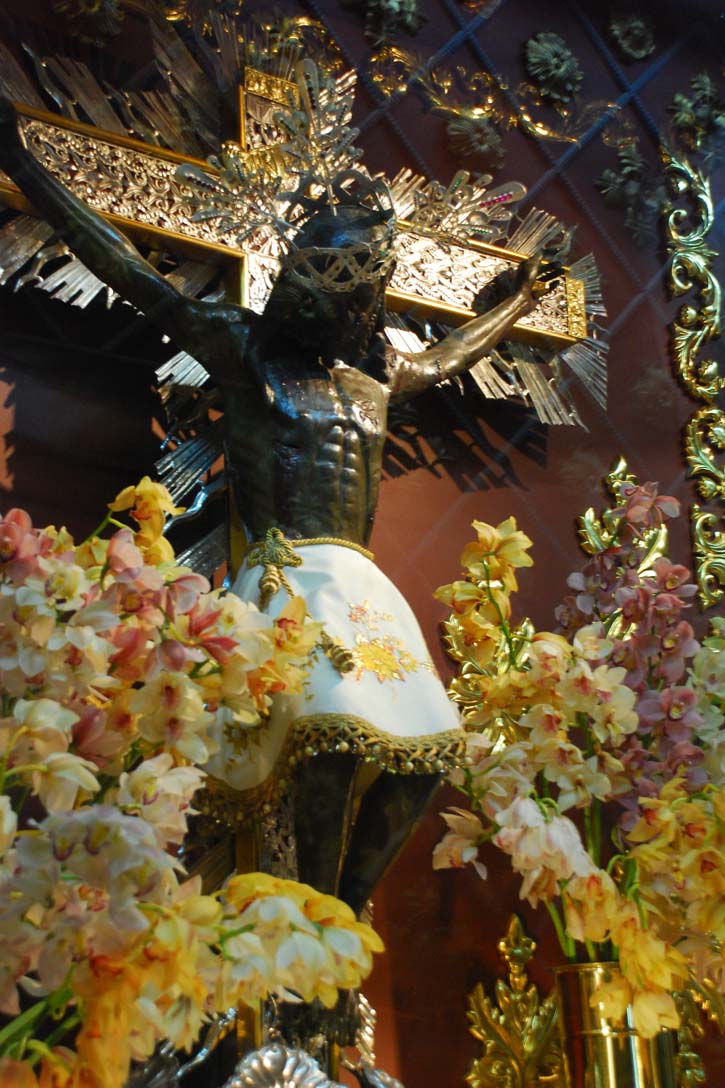The city of Guadalajara de Buga (pop. 115,000), founded in 1555, was one of the first cities established by the Spaniards in New Granada. It is best known as a place of pilgrimage. More than a million Colombian faithful come each year to pray at the Basílica Señor de los Milagros. Buga may not be chock full of attractions, but it is an excellent launching point from which to discover many lesser-known sights and breathe the fresh air of the Valle de Cauca. Plus, it’s a friendly kind of place.
Praying to the “Black Christ” is believed to provide miracles, and the story behind this icon is one of generosity, devotion, and miracles.The star attraction in town for religious pilgrims is the Basílica Señor de los Milagros (Cra. 14 No. 3-62, tel. 2/228-2823, 5:30am-7:30pm daily). Built in the early 20th century, this pink church is not of architectural significance: It’s known for its “Cristo Negro” or Señor de los Milagros—a charred woodcarving of Christ that is displayed in a chapel behind the altar.
Señor de los Milagros is a charred woodcarving of Christ that is displayed in a chapel behind the altar of the Basílica Señor de los Milagros. Photo © Mario Carvajal, licensed Creative Commons Attribution.
Praying to the “Black Christ” is believed to provide miracles, and the story behind this icon is one of generosity, devotion, and miracles. In colonial times an indigenous woman who had converted to Christianity saved for years to purchase a crucifix. One day a man crossed her path crying because he’d go to jail if he didn’t pay a debt. The woman showed her generosity to by giving him all the money she had saved. Months later, she noticed a small crucifix floating down the river towards her. She picked it up and made an altar to pray to it. The crucifix grew in size, prompting her and others to believe it had miraculous powers. After years of deterioration, the church decided to burn it and replace it with another, but it never burned, remaining charred and black—another miracle.
The shops lining the Avenida del Milagroso, a pedestrian walkway leading to the church, sell all manner of basilica-related trinkets. Each September 14 there is a large procession in and around town featuring the Señor de los Milagros. It’s accompanied by special masses and ceremonies in the church.
The Parque Cabal (between Clls. 6-7 and Cras. 14-15) is the center of this slow-paced city. Old-timers drink their tinto (small cups of black coffee) in corner cafés in the late afternoon, engrossed in political conversations with their friends, while lottery vendors circulate among the tables hoping to sell a couple of tickets. On the corner of Calle 6 and Carrera 15 is the Catedral de San Pedro (8am-noon and 2pm-6pm Mon.-Fri.), a beautifully preserved, three-nave church that was originally built in the 16th century. It is a couple of blocks west of the park.
Buses depart Cali for Buga all day long. Tickets cost around COP$8,000, and the journey through the sugarcane plantations of the Valle takes under two hours. Buses will often leave you at the main highway, and from there you’ll have to walk about 20 minutes or take a cab into town. Cabs are always at the ready to meet arriving buses, and this is easy to do. The pleasant open-air Buga bus station, modern and clean, is a straightforward 15-minute walk from the Buga Hostel.
Excerpted from the First Edition of Moon Colombia.